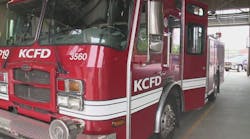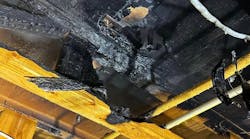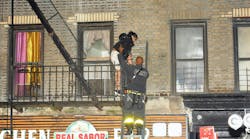"The serious losses in life and property resulting annually from fires cause me deep concern. I am sure that such unnecessary waste can be reduced. The substantial progress made in the science of fire prevention and fire protection in this country during the past forty years convinces me that the means are available for limiting this unnecessary destruction." There is not a single book about fire prevention and fire administration in America that does not have a similar statement about the fire problem in our country. But while this statement appears to be an accurate depiction of our country's current fire problem, interestingly enough, this statement belongs to 60 years ago, and was a part of President Harry S. Truman's address to the 1947 President's Conference on Fire Prevention.
We have indeed made great strides toward protecting our citizens from the wrath of fire. Yet, the perfect applicability of President Truman's statement to our current conditions clearly reveals the fact that we are still struggling with the same problems and trying to overcome the same obstacles, and that we are not much further along as we would have wanted to be after almost six decades. The report and all of the recommendations of the 1947 Fire Prevention Conference are posted on the United States Fire Administration (USFA) website at www.usfa.fema.gov/about/47report.shtm.
Even though it was called "The President's Conference on Fire Prevention," the 1947 conference was not about fire prevention in specific, but about ways to reduce the total national fire loss which, at that time, was approaching 750 million dollars. In their description of the 1947 conference, USFA's website states: "Almost none of this country's current fire prevention and risk reduction managers were at all knowledgeable about the meeting, where some 2,000 of the Nation's leaders in business, industry, government, military, higher education, and the fire service gathered together, at the Federal government's expense, in Washington, DC in May 1947. Today, if such could be undertaken again, the attendees names would read like a list of Who's Who in America with regard to those who are "shakers and movers" in our society - heads of major institutions, like the Fortune 500 types, leaders from both the public and private sector, etc."
President Truman challenged the conference to take action and outlined his vision that "It is the clear responsibility of every State and local official, and every citizen, to aggressively support this national war against the growing menace of fire." Back in 1947, they recognized that preventing fires in the first place was the best way to reduce the total fire loss in our country. And to this date that fact has remained unchanged.
Following Truman's Lead
The National Fire Protection Association's October 2005 report, "The Total Cost of Fire in the United States," indicates that in 2003 there were 3,925 fire fatalities, and the total property fire loss was 14.5 billion dollars, which was just a small portion of the overall $226-272 billion dollars total cost of fire in America. It is of obvious importance to focus on our mission to reduce the fire fatalities and the life-scarring fire injuries in our communities, and it is also our professional obligation to acknowledge our responsibility in decreasing our country's total fire cost.
But to succeed in addressing our country's fire problem and reducing our total national fire cost, we need the buy-in and a deep level of involvement and commitment from all affected stakeholders, not just the professionals in the fire protection field alone. We must promote the concept of organizing a national conference similar to the 1947 conference, inclusive of all stakeholders and all pertinent organizations, to discuss ways and come up with strategies to reduce our total national fire cost.
President Truman's idea was brilliant in getting all of the stakeholders to focus on stopping the economic drain caused by fire, and more importantly, to get society's buy-in. If it could be done 60 years ago, it could be done now. We need to organize a national conference similar in both scale and scope to the 1947 conference, to address all aspects of our national fire problem. What do we have to lose, after all?
No, we haven't been sitting idle for the past six decades, and under the leadership of the United States Fire Administration (USFA) there has been great and steady success in reducing fire fatalities. We have had the 1973 America Burning, the 1987 America Burning Revisited, and finally the 2000 America Burning Recommissioned reports. But, can we truly say that has been enough? No, not according to the 2000 America Burning Recommissioned report that states "America today has the highest fire losses in terms of both frequency and total losses of any modern technological society."
Realistically, despite their successes, none of those reports could compare to the 1947 conference with respect to the scope, significance and the full spectrum of participants. Don't get me wrong: I am a strong supporter of the USFA and its systematic, steady progress in enhancing and promoting the fire and life safety concepts in our country for the past 34 years. But after six decades, we certainly are not where we desire to be-not unless, as a society, we have reached the conclusion that losing 4,000 lives and spending one-quarter trillion dollars a year by fire is acceptable.
A National Issue with Local Consequences
The logical question is: If the 1947 conference was such a success, why are we still facing similar problems today? Some believe the reason might be deeply rooted in our constitutional separation of federal and state/local authorities and responsibilities. Back in 1947, they recognized that the fire problem is a national problem and they outlined the appropriate recommendations for the state and local governments to implement.
But, the federal government's recommendations were advisory in nature, and they could not require or force the state or local governments to implement any of them. That is why the 1947 conference did not identify either the funding source or the structured organizational mechanism to implement those comprehensive recommendations at the local levels. Without an organizational structure and mechanism, there was no accountability to insure implementation of those recommendations.
So why should we expect a different outcome the next time around? Or, rather, how could we have a better chance to succeed if had another full-scale national conference such as that which convened in 1947?
In fact, the federal government, through federal regulations, grants, and funding programs, indirectly imposes its will on state and local governments and private entities. Anyone familiar with Occupational Safety and Health Administration regulations and Environmental Protection Agency rulings knows this to be true. While many regulations become unfunded mandates, Congress has attached billions of dollars to many important programs whose impact is felt most strongly at local levels yet improves us nationally, as well.
They say money talks. And people tend to listen. With the federal government holding the purse, state and local governments tend to be all ears. When we talk about finding proactive ways to reduce our multi-billion-dollar annual fire cost, we need to be fiscally creative-and don't forget, there are long-established federal funding mechanisms and grants currently funneled into the local governments that could be leveraged and expanded to suit this purpose. The EPA doesn't seem to have a problem in enforcing federal standards and regulations through their (so-called) "voluntary pollution management goals." If it works well for the EPA, why shouldn't it work for us? Since 1947, there have been many successful federal programs that could provide us better chance of success than the 1947 conference. We must try to find our best fit. We need to analyze the problem and "think outside the box," as they say. What do we have to lose, after all?
What a New President's Conference Would Do
A new conference on solving the American fire problem ultimately would lead us to the same general conclusion as the 1947 conference: We need to focus more on fire prevention and utilizing all available technologies to address the fire problem. Sure, we in the fire protection field might believe that we know the answers already, but the important point is obtaining the support of all stakeholders and getting their buy-in and commitments. That is the key, because full-scale commitment would drive a campaign that would hopefully result in better funding and implementation mechanisms for the recommendations. What do we have to lose by focusing on finding better solutions to address the fire problem? Why shouldn't we have a national conference, then?
One of the most important outcomes of a national conference could either be the next stage in the evolution of the USFA and expansion of its role, or the establishment of a new federal agency, similar to the EPA, responsible for reducing our total national fire cost. Accountability for reducing our total national fire cost could be the best outcome of this national conference.
Taking corrective measures to avoid financial loss is an everyday event in the private sector but it is rather uncommon in the government-especially at the federal level. General Motors' drastic steps to correct its $2.2 billion losses in the first quarters of 2005 made national news. But even with a yearly toll of 4,000 deaths and $14.5 billion in property losses from fire, the national consciousness is not roused to waken, much less act. Our fire statistics seem to be lost among many other numbers, but it is our duty to shed light on them and bring them up to the attention of the national policymakers. I truly believe that if our representatives on Capitol Hill were aware of the real magnitude of our country's fire cost year after year, they would pay a lot closer attention to address the fire problem in our country.
It's an accountability issue. The CEO of a corporation is held accountable by stockholders for the bottom line profitability and economic well being of the company-today and in the future. Who is held accountable for our national fire losses? Who are our "stockholders"? Who is accountable for taking corrective measures and changing course to avoid having such huge national annual costs every year? How are our performance levels measured?
Year in and year out, there are fires and we respond and put them out, without any accountability for the past or for future fire fatalities and fire costs. But that accountability is our duty; we have a patriotic duty to America's physical and economic well-being. A national conference on reducing our fire costs will identify shortcomings, yield critical recommendations to address the problems, and establish a system for bringing accountability into the equation. Without a system and accountability, nothing will change.
Since General Motors' financial troubles and its massive layoffs might seem as a rather unpleasant example from the labor's view, let me clear up a very important point here from the fire service perspective: I believe that a few decades back, our general view in the fire service might have been that reducing fire losses meant fewer fires, thus layoffs for career firefighters. And that could have been the reason for our reluctance in accepting fire prevention as a priority for the fire service. But, our current work loads attest to the fallacy of that view. These days, only 20 percent our call volumes are fire/rescue-related and the other roughly 80 percent of our calls are EMS related, so that archaic belief could not possibly be true anymore-and especially so now with terrorism response on our plates.
There is no doubt that many career departments are running shorthanded and below establishing staffing standards. Insufficient staffing reduces effectiveness (and worse) and directly impacts our ability to reduce and control our fatalities and property losses from fires. So reversing the American fire losses could only mean additional resources and personnel for the fire service.
Having to reduce the national fire cost could make the municipalities more accountable to perform their obligations to protect their communities from the effects of fires. That could mean that municipal decisions in downsizing and reducing staff levels or shutting down fire stations etc. would be a lot more difficult to explain to the taxpayers, especially if the jurisdiction and the state stand to lose federal grants for noncompliance with the fire loss reduction regulations. Keeping local jurisdictions responsible for compliance could only translate to more fire suppression resources and firefighters for the community, as was identified in NFPA's "U.S. Fire Department Profile Through 2003." It would be better for everyone-management, labor, and the citizens.
In addition to the operational components - the "back end" of the fire safety process-a new presidential conference would focus the appropriate attention on the "front end" - preventing fires and better utilizing technologies to limit the spread of fire. Truly, as the USFA and NFPA positions strongly underscore, fire prevention efforts and fixed fire protection systems in the built environment are the keys to the reduction of America's fire losses. Such a conference would be to take a giant step forward in safety and property conservation in a way we haven't done before. It would bring all members of society-from government to private enterprise to American taxpayers-into the effort.
To win this battle, heavy artillery is needed, and the big guns need to roar. A single person will not be able to do much, but if the grassroots support is there, then there is a better chance of success. There is a Japanese saying that "vision without action is a dream; action without vision is a nightmare." We have the vision, so we need to act; otherwise it is only a dream.
What do we have to lose? As Americans, annually about 4,000 lives and one quarter of a trillion dollars-two percent of our gross domestic product (GDP). What do we have to lose? As fire protection professionals, nothing but the complacency that has shackled us down.
Azarang (Ozzie) Mirkhah, Firehouse.com Contributing Editor, is the Fire Protection Engineer (FPE) for the City of Las Vegas Department of Fire & Rescue. His responsibilities include reviewing all building fire and life safety system designs and submittals to insure compliance with the federal, state and local fire and life safety codes and standards. Mr. Mirkhah is also involved in the development of fire & life safety codes and standards for the city.
Mr. Mirkhah is a registered professional engineer with more than 25 years of work experience in the field of fire protection engineering. Mr. Mirkhah joined the Las Vegas Fire & Rescue (LVF&R) more than 12 years ago. Prior to that Mr. Mirkhah worked as a consultant designing fire protection systems for some of the most internationally recognized fire protection consulting firms.
Mr. Mirkhah holds a Bachelor of Science degree in Mechanical Engineering (BSME), and a Masters degree in Public Administration (MPA). Mr. Mirkhah is a 1999 graduate of the National Fire Academy's Executive Fire Officer Program. Mr. Mirkhah is a Certified Building Official, Certified Fire Inspector, Certified Mechanical Inspector, and Certified Plans Examiner through the International Code Council (ICC).
Mr. Mirkhah is a member of the National Fire Protection Association (NFPA) and serves on the national NFPA 13 Technical Committee for Sprinkler System Discharge Design Criteria. Mr. Mirkhah is a member of the Society of Fire Protection Engineers (SFPE) a member of the Institution of Fire Engineers (IFE) - USA Branch. Mr. Mirkhah is also a member of the International Association of Fire Chiefs (IAFC). You can contact Mr. Mirkhah at: [email protected]. To view all of Ozzie's articles on Firehouse.com, please click here.





